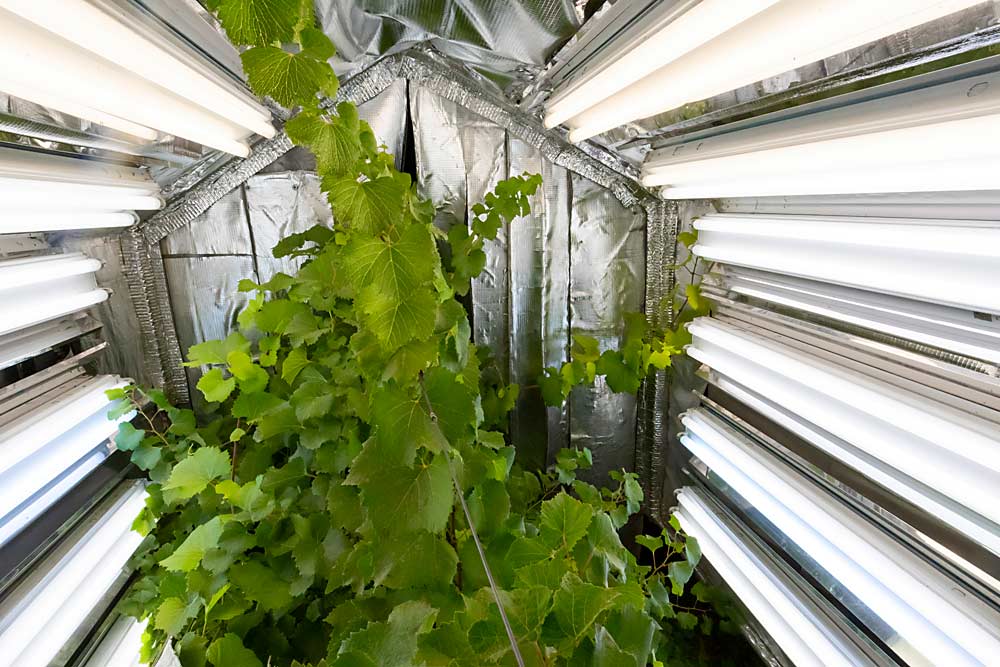
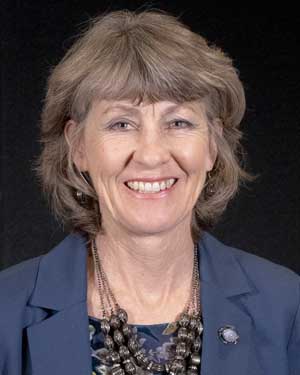
An innovative and sustainable way to control grape powdery mildew in wine grapes is under evaluation in Washington state, thanks to collaboration between Washington State University and scientists at Cornell University, the University of Florida, the Norwegian University of Life Sciences, and Mount Sinai Hospital, with support from the Washington wine industry.
This technology uses a type of ultraviolet light, UV-C, at a short wavelength of 254 nanometers to zap harmful grape pathogens. Research has shown certain wavelengths of UV can be used to suppress plant pathogens, including the fungus that causes powdery mildew.
UV-C technology has been used in hospital and food safety applications for more than 70 years to help control harmful microorganisms, but more recently its use has been expanded to agriculture. The technology was first tried on wine grapes at Cornell University more than 30 years ago, with mixed results. But a breakthrough by a member of a research team in Norway in 2012 revealed that UV-C light could suppress powdery mildew, as well as many other plant pathogens and even insect pests, in diverse crops — including cucumbers, strawberries, tomatoes and apples — if applied at the right time. This discovery has brought cutting-edge innovation and excitement to the world of plant pathology and Washington’s wine industry.
The U.S. and European strawberry industries, dealing with fungicide resistance and the loss of several pesticides in Europe, were early adopters of the UV-C technology. Autonomous robotic units that apply UV-C on strawberries and other crops are now commercially available from the Norwegian company Saga Robotics.
The UV-C technology has great potential for grapes, too, and is being tested at several locations. Collaboration between Cornell and WSU and the support of the Washington wine industry are an important part of that researach.
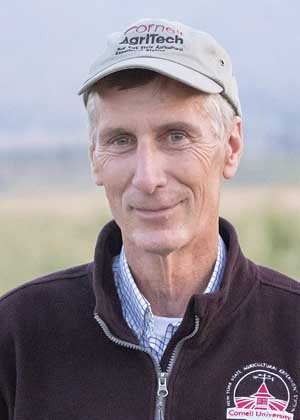
Collaboration
The wine grape trials in Washington expand the work of David Gadoury, a plant pathologist at Cornell University, who is the project director of a research and extension group that stems from a U.S. Department of Agriculture Organic Research and Extension Initiative project lasting from 2014 to 2020. That work has now been expanded to include the Washington wine industry.
The Washington UV-C investigation, in its second year, is led by Michelle Moyer, statewide extension viticulture specialist for WSU. Her research, funded by Washington State University, the Auction of Washington Wines and all Washington state wine grape growers and wineries through the Washington State Wine Commission, expands the knowledge on UV-C effectiveness in eastern Washington. A similar investigation is underway in Oregon’s wine industry, led by USDA scientists in Corvallis.
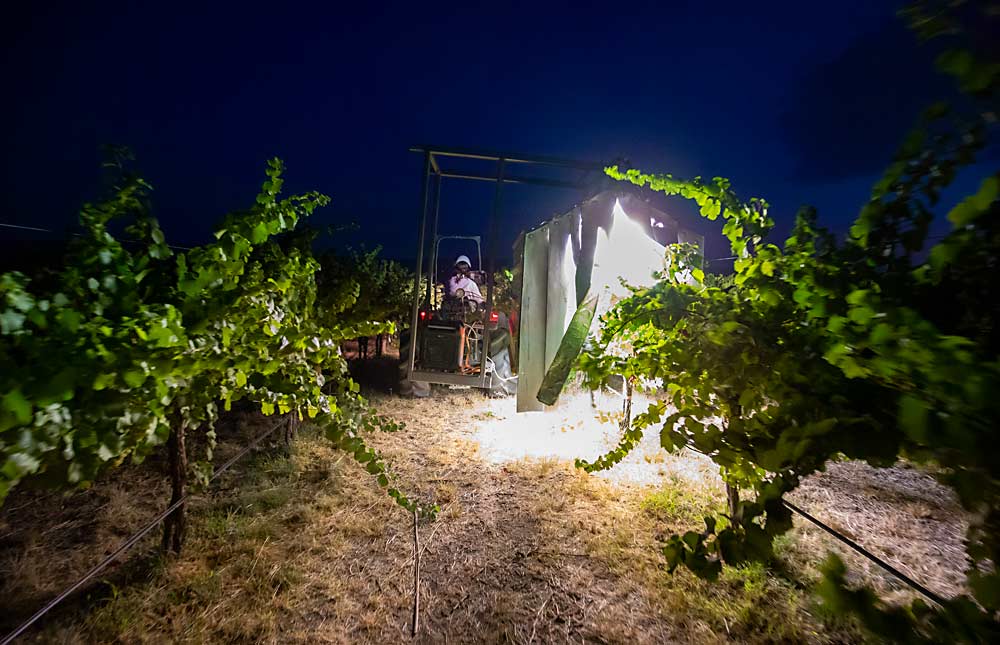
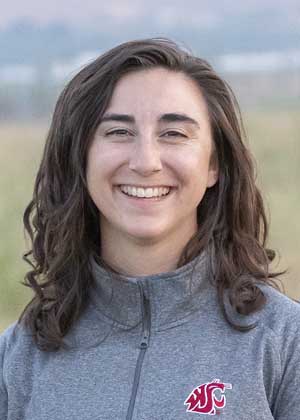
Moyer’s collaboration is a natural fit: She received her doctorate in plant pathology from Cornell, where Gadoury was her co-advisor. Gadoury shared UV-C light arrays, equipment and engineering designs with Moyer, and her graduate student, Alexa McDaniel, assembled WSU’s unit in 2019. The original trailered unit was upgraded in 2020 to a 3-point-hitch-mounted unit suspended from a cantilevered arm. Gadoury visited Moyer’s research trial in late August 2021.
This kind of teambuilding and sharing of emergent technologies is important to the Washington wine industry. Collaboration can maximize the impact of a project, enhance a researcher’s network and help bring global awareness to the Washington wine industry’s research program. The collaboration between Gadoury and Moyer is a great example of this process.
Other examples include WSU collaboration between Markus Keller and the University of Bordeaux, France; Naidu Rayapati and the University of Florida; and Jim Harbertson and the University of California, Davis, to name a few. On a broader scale, the Washington State Wine Commission and the Washington Tree Fruit Research Commission are looking for ways to work together on common research issues.
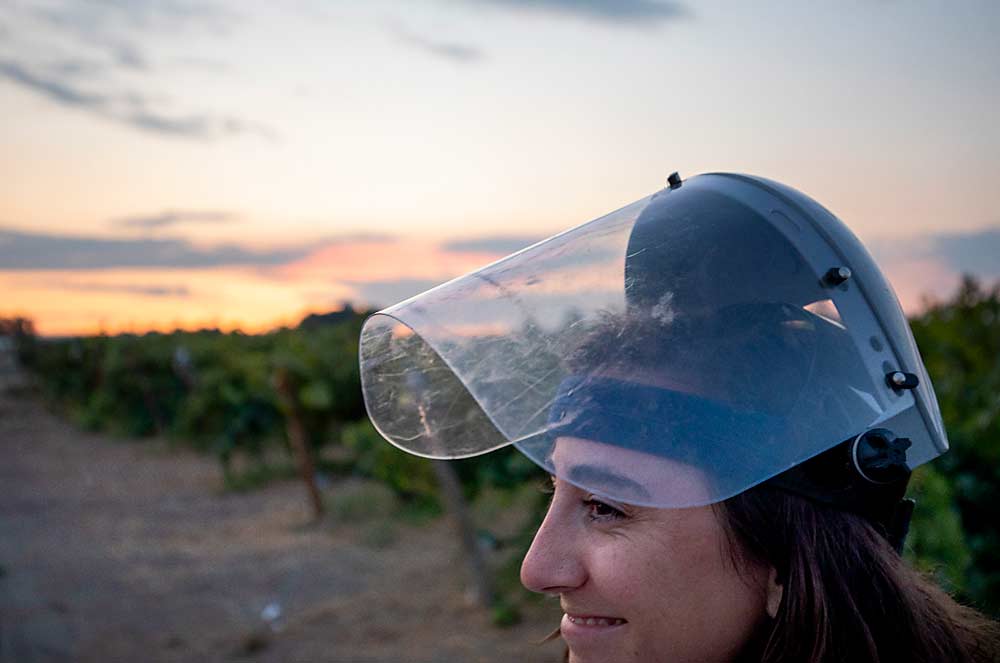
Washington UV-C trials
Moyer said her goal is to learn the optimum timing and intervals for “UV-C light therapy” in Washington vineyards. She believes UV-C light could offer growers a nonchemical tool to control powdery mildew, particularly in the early season, as well as help reduce selection for fungicide resistance. Her trial evaluates how the UV-C therapy fits within existing spray programs and as a stand-alone option. The trial in the WSU research vineyard in Prosser compares two different UV-C timing strategies and different intervals to a conventional fungicide program. Treatment intervals are from 3 to 14 days. The four treatments include:
1) Early-season UV-C therapy, then traditional fungicide program.
2) Full-season UV-C therapy.
3) Traditional fungicide program.
4) Untreated control.
In addition to monitoring disease severity, she is measuring fruit quality — with both chemical and sensory analysis — to ensure that UV-C light doesn’t negatively impact fruit quality. The sensory evaluation on fruit will be the most extensive yet for the UV-C technology and will add greatly to the UV-C knowledge base on wine grapes. She is also monitoring for UV-C impact on fungicide resistance.
Earlier work has shown excellent suppression of spider mites and sour rots and mild suppression of downy mildew. Suppression of insect pests — spider mites, grape mealybugs and leafhoppers — will be evaluated in future WSU studies.
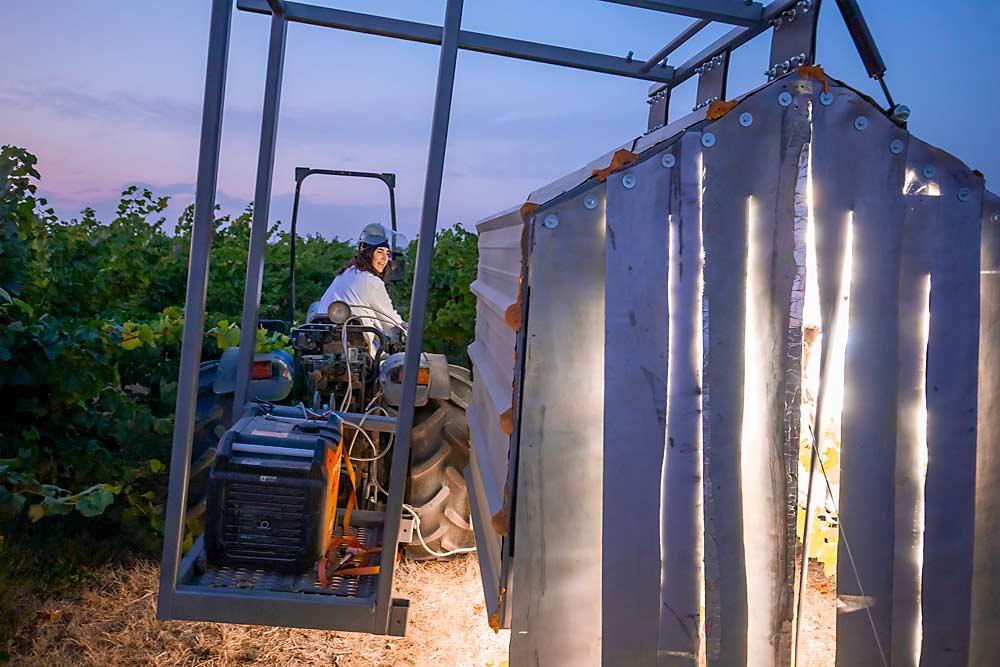
Research breakthrough
Gadoury’s first work with UV-C light began three decades ago. While shortwave UV exposure damages the DNA of powdery mildew, the pathogen evolved to be able to survive a world that’s bathed in sunlight by using blue light (in the sunlight spectrum) to repair the damage to its DNA, he said during a webinar hosted earlier this year by the Washington State Wine Commission and WSU.
The repair of UV-inflicted damage by the blue light component of sunlight is one reason why Gadoury’s initial approach in 1991 fell short on grapes. The high daytime UV-C dosage needed to kill the powdery mildew also defoliated the grapevines and made the berries look like tiny potatoes.
In 2011, a doctoral student, Aruppillai Suthaparan, with whom Gadoury worked at the Norwegian University of Life Sciences, found that applying the UV-C light at night, followed by several hours of darkness, circumvented the powdery mildew’s ability to repair its DNA. That’s because the blue light needed for DNA repair is absent at nighttime. Thus, the powdery mildew cells could not repair themselves. Moreover, the nighttime application required a fraction of the previous dosage — less than 10 percent of what was needed in daylight. This lower dosage caused none of the earlier phytotoxic effects to the fruit and grapevine.
The UV-C light dose is measured in joules per square meter, which is defined as watts per square meter per second. So, grapevines exposed to 50 watts of UV-C energy for 4 seconds receive a cumulative dose of 200 joules per square meter. That’s the rate WSU is using. Optimal results are obtained when at least 4 hours of darkness follow the UV-C application. With long summer daylight hours — nearly 18 hours at the summer solstice in the Pacific Northwest — the speed of UV application is a critical factor governing the vineyard acres that can be covered between sunset and sunrise.
While it’s too early for Moyer to share trial results, preliminary data and trends of the UV-C treatments show acceptable levels of disease control. Moyer said that while UV-C may not be better than traditional management approaches, it appears to be a viable alternative with equally acceptable levels of control, and with significant advantages with respect to freedom from residues and fungicide resistance. Already, a couple of Washington wine grape growers are interested in building their own units this winter.
This collaboration has positioned Washington’s wine industry to be on the cutting-edge development of the UV-C technology. Vineyard trials conducted in Washington, while the technology continues to be refined and improved for our growing conditions, provides grape growers opportunity for early adoption. Kudos to scientists that share the Washington wine industry’s vision of collaborative and innovative research and who are willing to take initiative and the extra effort involved with such projects. We look forward to expanding research collaboration in the future.
Members of the research and extension team and advisory committee for the Light and Plant Health project include: Laura Pedersen, Pedersen Farms, New York; Eric Sideman, Northeast Organic Farming Association; Aruppillai Suthaparan, Norwegian University of Life Sciences; Arne Stensvand, Norwegian Institute of Bioeconomy Research; Mariana Figueiro and Mark Rea, Mount Sinai Light and Health Research Center; Ole Myhrene, Norway; Rebecca Sideman, University of New Hampshire; and Natalia Peres and doctoral student Rodrigo Onofre, University of Florida. Also, Robert Seem, David Gadoury and Jan Nyrop of Cornell University; Lance Cadle-Davidson, USDA-Agricultural Research Service, New York; Walt Mahaffee, USDA-ARS, Oregon; and Michelle Moyer, Washington State University.
—by Melissa Hansen

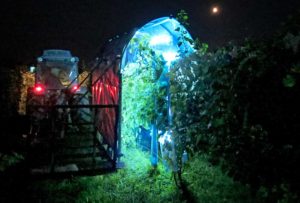
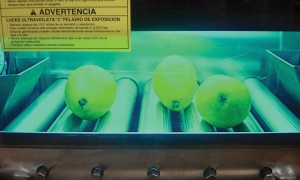





Leave A Comment